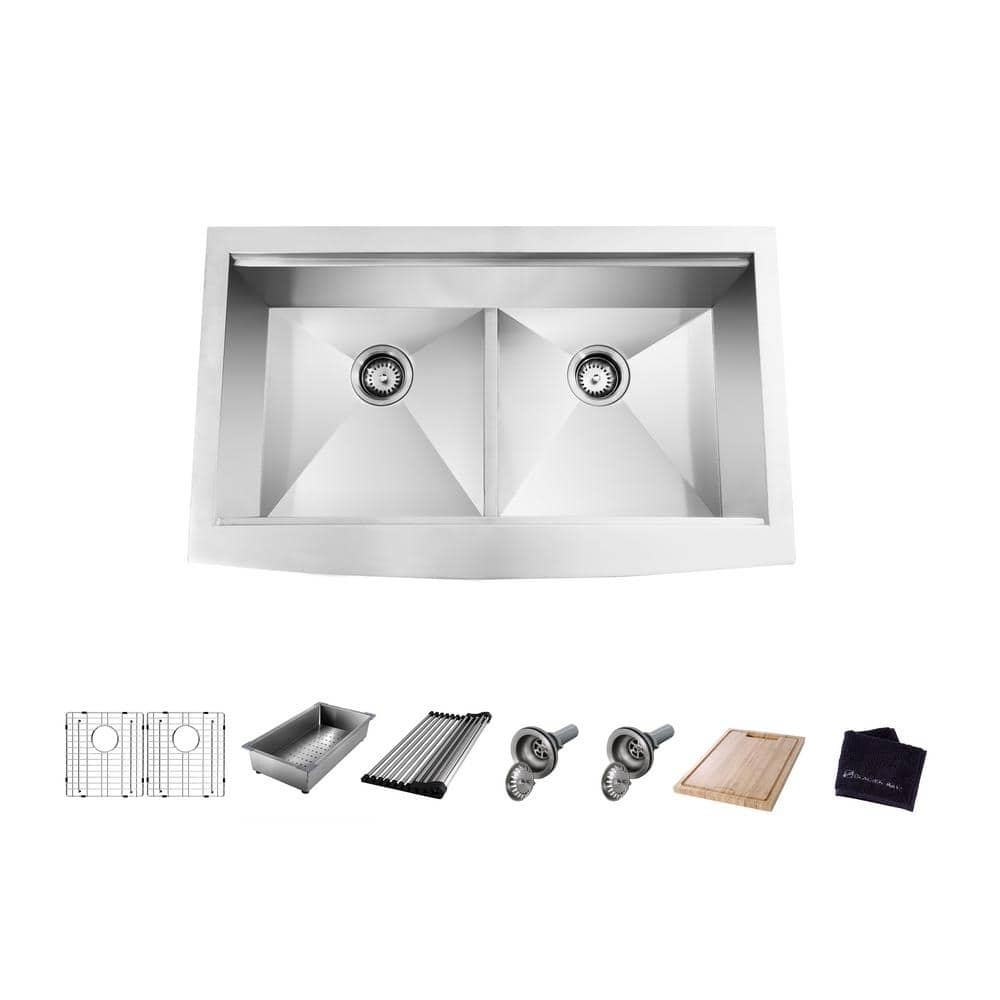Glacier Bay Zero Radius Farmhouse Apron-Front 18G Stainless Steel 33 in. 50/50 Double Bowl Workstation Kitchen Sink with Accessories
33 in. x 22 in. x 10 in. minimum cabinet size 36 in. Workstation farmhouse sink with ledge for sliding accessories. Includes cutting board, grids, drains, colanders, dry rack.
If you enjoy cooking like a professional chef, the Glacier Bay Workstation Sink for you. This Apron-Front Farmhouse Sink features an extra-large bowl that is generously sized for any food preparation or clean up that you could undertake in your kitchen, and the kit includes a custom cutting board, colander and roll-mat, all designed to fit the workstation ledge. Each model is handcrafted from high quality, virgin 304 18-8 heavy gauge stainless steel, and is sound insulated with noise absorbing pads plus under-spray coating.
- Workstation sink with single-tier track for sliding the built-in accessories
- Includes bamboo cutting board, deep stainless steel colander, and dish-drying roll-up rack that slide on the ledges converting your sink to a workspace
- Also included in kit: bottom rinse grid, drain strainer, cutout template, mounting clips and installation manual
- 18-Gauge premium T-304 grade stainless steel (18/10 chromium/nickel) with commercial grade brushed finish for superior stain and rust resistance
- Heavy duty sound guard undercoating and thick rubber padding to minimize noise and reduce condensation
- Sloped bottom with grooves to allow complete water drainage, and zero radius corners for a clean modern look
Additional information
| Actual Left to Right Length (In.) | 33 |
|---|---|
| Bowl Top to Bottom Depth (in.) | 10 |
| Cut-Out Below Counter Depth (in.) | 10 |
| Cut-Out Depth (in.) | 19.49 |
| Cut-Out Width (in.) | 30.2 |
| Kitchen Sink Front to Back Width (In.) | 22 |
| Left Inner Bowl Below Counter Depth (in.) | 10 |
| Left Inner Bowl Front to Back Width (in.) | 16 |
| Left Inner Bowl Left to Right Length (in.) | 14.5 |
| Panel Height (in.) | 10 |
| Panel Width (in.) | 33 |
| Right Inner Bowl Below Counter Depth (in.) | 10 |
| Right Inner Bowl Front to Back Width (in.) | 16 |
| Right Inner Bowl Left to Right Length (in.) | 14.5 |
| Manufacturer Warranty | Limited Lifetime |






by David
The farm sink came with surprisingly low cost and lots of accessories. The other products sink cost itself was higher than combined cost. It’s easy to install, use, clean.
by Janice
I love the look of this and workability upfront….that said I am still waiting to have it installed so will update thereafter.
by Agata
I got disappointed when I noticed some rust around the corner of the bowl. I also noticed fingerprint outside in the front.
by Christine
It’s beautiful just like the one I have been dreaming of. Haven’t installed it yet because I’m waiting for my cabinets so can’t comment on that part yet. But overall for now I love it.
by Chris
I love this sink! All the accessories are great. It looks awesome in my kitchen and functions wonderfully!